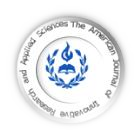
GENERAL INFORMATION

| ISSN: 2429-5396 (e) | www.american-jiras.com | |
| Web Site Form: v 0.1.05 | JF 22 Cours, Wellington le Clairval, Lillebonne | France |
| Web Site Form: v 0.1.05 | JF 22 Cours, Wellington le Clairval, Lillebonne | France |

| HOME | ABOUT US | ARCHIVE | AIMS AND SCOP | AUTHORS | REVIEW | SUMIBMIT MANUSCRIPT | EDITORIAL BOARED | PUBLICATION FEE |
| | ARTICLES | Am. J. innov. res. appl. sci. Volume 11, Issue 3, Pages 193-198 (September 2020) |
| Research Article 9 |


|
American Journal of innovative
Research & Applied Sciences
Research & Applied Sciences
ISSN 2429-5396 (Online)
OCLC Number: 920041286
OCLC Number: 920041286
| HOME || ABOUT US || ARCHIVES || AIMS AND SCOP || AUTHORS || REVIEW|| SUBMIT MANUSCRIPT || EDITORIAL BOARD || CONTACT US |

| SEPTEMBER | VOLUME 11 | N° 3 | 2020 |

| Info-AJIRAS-® Journal ISSN 2429-5396 (Online) / Reference CIF/15/0289M |
American Journal of Innovative Research & Applied Sciences
Authors Contact
*Correspondant author and authors Copyright © 2020:
| Agbémébia Y. Akakpo 1* | Larounga Tchaniley 2 | Elolo G. Osseyi 1| and | Tchadjobo Tchacondo 1 |
Affiliation.
1. Laboratoire des Sciences Biomédicales, Alimentaires et de Santé Environnementale [LaSBASE] | Ecole Supérieure des Techniques Biologiques et Alimentaires (ESTBA) | Université de Lomé | Togo, BP : 1515, Lomé-Togo |
2. Laboratoire de Recherche sur les Agroressources et la Santé Environnementale (LARASE) | Ecole Supérieure d’Agronomie (ESA) | Université de Lomé | Togo, BP : 1515, Lomé-Togo |
This article is made freely available as part of this journal's Open Access: ID | Agbémébia-Ref.1-ajira310820 |
*Correspondant author and authors Copyright © 2020:
| Agbémébia Y. Akakpo 1* | Larounga Tchaniley 2 | Elolo G. Osseyi 1| and | Tchadjobo Tchacondo 1 |
Affiliation.
1. Laboratoire des Sciences Biomédicales, Alimentaires et de Santé Environnementale [LaSBASE] | Ecole Supérieure des Techniques Biologiques et Alimentaires (ESTBA) | Université de Lomé | Togo, BP : 1515, Lomé-Togo |
2. Laboratoire de Recherche sur les Agroressources et la Santé Environnementale (LARASE) | Ecole Supérieure d’Agronomie (ESA) | Université de Lomé | Togo, BP : 1515, Lomé-Togo |
This article is made freely available as part of this journal's Open Access: ID | Agbémébia-Ref.1-ajira310820 |
ABSTRACT
Background: The larvae of Rhynchophorus phoenicis from palm trees (Elaeis guineensis) can be good food sources but remain little used because of lack of knowledge. Objective: This work involves nutritional assessment of the larvae of the palm trees and its consumption knowledge. Methods: Sectional study was conducted among people in Lomé. Data were collected using questionnaires. The proximate composition moisture, protein levels, fat content, carbohydrates content, ash and essential minerals contents were determined. Results: The analysis carried out focused on the dried and roasted larvae. Though the larvae of palm trees were known by 71.43% of people, they’re less consumed due to the lack of nutritional knowledge. More than 80% of people consume larvae dried or roasted. The proximate composition of the larvae of the palm tree showed that they are rich in protein and fat. The effect of the cooking method was examined and the results obtained showed that, with the exception of proteins value 29.57 ± 0.49% for roasted larvae, the dried larvae contain more lipids (60.16 ± 1.73%), proteins (30.69 ± 0.70%), mineral matter such as calcium (13.94 ± 4.63%), magnesium (237.33 ± 6.61%) and iron (15.38 ± 1.00%). Statistical difference (p > 0.05) was noted between dried and roasted larvae samples for each parameter expects proteins content. Conclusion: The larvae of the palm trees contain not only proteins and fat, but also major minerals. The larvae could be transformed into different value-added products for human nutrition due to its nutritional properties. This larva may constitute a cheaper source of essential nutrients that is easily available and affordable to the natives within the localities where the larvae are found.
Keywords: Palm trees, Rhynchophorus phoenicis, nutritional value, consumption, Togo.
Background: The larvae of Rhynchophorus phoenicis from palm trees (Elaeis guineensis) can be good food sources but remain little used because of lack of knowledge. Objective: This work involves nutritional assessment of the larvae of the palm trees and its consumption knowledge. Methods: Sectional study was conducted among people in Lomé. Data were collected using questionnaires. The proximate composition moisture, protein levels, fat content, carbohydrates content, ash and essential minerals contents were determined. Results: The analysis carried out focused on the dried and roasted larvae. Though the larvae of palm trees were known by 71.43% of people, they’re less consumed due to the lack of nutritional knowledge. More than 80% of people consume larvae dried or roasted. The proximate composition of the larvae of the palm tree showed that they are rich in protein and fat. The effect of the cooking method was examined and the results obtained showed that, with the exception of proteins value 29.57 ± 0.49% for roasted larvae, the dried larvae contain more lipids (60.16 ± 1.73%), proteins (30.69 ± 0.70%), mineral matter such as calcium (13.94 ± 4.63%), magnesium (237.33 ± 6.61%) and iron (15.38 ± 1.00%). Statistical difference (p > 0.05) was noted between dried and roasted larvae samples for each parameter expects proteins content. Conclusion: The larvae of the palm trees contain not only proteins and fat, but also major minerals. The larvae could be transformed into different value-added products for human nutrition due to its nutritional properties. This larva may constitute a cheaper source of essential nutrients that is easily available and affordable to the natives within the localities where the larvae are found.
Keywords: Palm trees, Rhynchophorus phoenicis, nutritional value, consumption, Togo.
Corresponding author Author and Copyright Author © 2020: | Agbémébia Y. Akakpo 1* | |. All Rights Reserved. All articles published in American Journal of Innovative Research and Applied Sciences are the property of
Atlantic Center Research Sciences, and is protected by copyright laws CC-BY. See: http://creativecommons.org/licenses/by-nc/4.0/
BIOCHEMICAL COMPOSITION AND NUTRITIONAL VALUE OF LARVAE OF RHYNCHOPHORUS PHOENICIS COLLECTED FROM ROT PALM TREES (ELAEIS GUINEENSIS) IN PALM GROVES IN TOGO
| Agbémébia Y. Akakpo 1* | Larounga Tchaniley 2 | Elolo G. Osseyi 1 | and | Tchadjobo Tchacondo 1 |. Am. J. innov. res. appl. sci. 2020; 11(3):193-198.
| PDF FULL TEXT | | XML FILE | | Received | August 31, 2020 | | Accepted | September 11, 2020 | | Published | September 20, 2020 |
| Agbémébia Y. Akakpo 1* | Larounga Tchaniley 2 | Elolo G. Osseyi 1 | and | Tchadjobo Tchacondo 1 |. Am. J. innov. res. appl. sci. 2020; 11(3):193-198.
| PDF FULL TEXT | | XML FILE | | Received | August 31, 2020 | | Accepted | September 11, 2020 | | Published | September 20, 2020 |